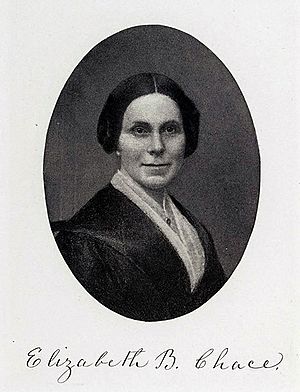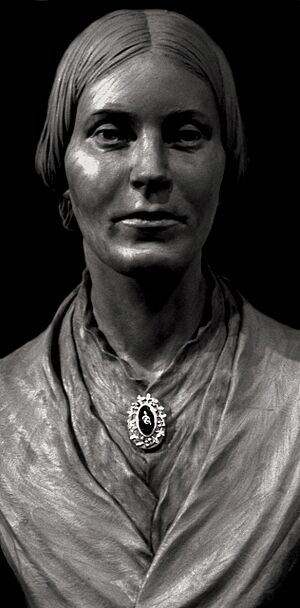Elizabeth Buffum Chace facts for kids
Quick facts for kids
Elizabeth Buffum Chace
|
|
|---|---|
 |
|
| Born | December 9, 1806 Providence, Rhode Island, U.S.
|
| Died | December 12, 1899 (aged 93) |
| Resting place | Swan Point Cemetery, Providence, Rhode Island, U.S. |
| Nationality | American |
| Known for | Activist |
| Spouse(s) |
Samuel Buffington Chace
(m. 1828) |
| Children | 10, including Arnold and Lillie |
| Relatives |
|
Elizabeth Buffum Chace (born December 9, 1806 – died December 12, 1899) was an important American activist. She worked hard for many causes in the 1800s. These included ending slavery, gaining rights for women, and improving prisons.
She was recognized for her work in 2002. She was added to the Rhode Island Heritage Hall of Fame.
Contents
Early Life and Family Roots
Elizabeth Buffum Chace was born Elizabeth Buffum. Her birthday was December 9, 1806, in Smithfield, Rhode Island. Her parents were Arnold Buffum and Rebecca Gould. Both the Buffum and Gould families were very old families in New England.
Elizabeth grew up as a Quaker. Quakers believed in equality for all people. Her family was strongly against slavery. Her father, Arnold, was even the president of the New England Anti-Slavery Society. This group worked to end slavery.
Marriage and Early Activism
On April 4, 1828, Elizabeth married Samuel Buffington Chace. He was also a Quaker from an old New England family. After her marriage, Elizabeth became very active in the movement to end slavery.
Samuel shared Elizabeth's beliefs. Together, they made their home a safe place for runaway slaves. Their home in Valley Falls, Rhode Island was a "station" on the Underground Railroad. This was a secret network that helped slaves escape to freedom in Canada. This was a very brave and risky thing to do.
Elizabeth and Samuel had ten children. Sadly, five of them died young from common diseases of that time.
In 1835, Elizabeth helped start a new group. It was called the Fall River Female Anti-Slavery Society. The original anti-slavery group had trouble letting free Black women join. Elizabeth and her sisters believed that all racist practices should end. They wanted to fight against all forms of racism, not just slavery.
Fighting for Freedom During the Civil War
When the American Civil War started in 1861, the Chaces kept working to outlaw slavery. They supported the Union side. However, they were disappointed that President Abraham Lincoln did not end slavery right away.
Elizabeth Buffum Chace met and wrote to many important anti-slavery leaders. She spent time with William Lloyd Garrison, Frederick Douglass, and William Wells Brown. She often welcomed them into her home.
Her family was very dedicated to the anti-slavery cause. For example, her sister Rebecca Buffum and Rebecca's son Edward traveled to Virginia. They went to visit John Brown in his jail cell. John Brown was an abolitionist who had tried to start a slave revolt. They got special permission to visit him. They wanted to offer him comfort. John Brown welcomed them warmly.
Later Life and Lasting Impact
In her later years, Elizabeth continued to fight for important causes. She worked for women's right to vote. She also pushed for reforms in prisons and workplaces.
She and other influential women helped create the Rhode Island State Home and School for Dependent and Neglected Children. This led to a law in 1884 to build a home for children who needed care. The school opened in 1885.
Elizabeth Buffum Chace passed away on December 12, 1899. She was 93 years old. She was buried at Swan Point Cemetery in Providence, Rhode Island.
The Conscience of Rhode Island
In 2001, Elizabeth Buffum Chace was given a special honor. The Rhode Island Secretary of State, Edward S. Inman III, chose her from many nominees. She was honored with a bronze bust in the Rhode Island State House. A bust is a sculpture of a person's head and shoulders. She was called "The Conscience of Rhode Island." This was because she worked tirelessly for people who were less fortunate.
This was a historic moment. It was the first time a sculpture of a woman was displayed inside the Rhode Island State House. The artist Pablo Eduardo created the bust.
Family's Influence on Education and Business
Elizabeth and Samuel's children and grandchildren also made important contributions. Their son, Arnold Buffum Chace, became the Chancellor of Brown University. He was also a famous mathematician. Their daughter, Lillie Buffum Chace Wyman, became an author. She wrote books and articles for magazines like The Atlantic Monthly. She was also a dedicated social reformer.
Their grandson, Malcolm Greene Chace, was a US Collegiate Tennis Champion. He is also known as the father of American ice hockey. Two other grandsons, Richard Chace Tolman and Edward Chace Tolman, became well-known professors. Richard was important in the Manhattan Project, which developed the atomic bomb. Edward was a pioneer in the study of behavior. He successfully fought against being fired from the University of California, Berkeley. This happened when he refused to sign a loyalty pledge during a time of political tension in the 1950s.
The Chace family is also famous for its involvement in making textiles. Their textile company, the Valley Falls Company, later became Berkshire Fine Spinning Associates. This company eventually became part of Berkshire Hathaway.
Impact on Child Welfare
Elizabeth Buffum Chace was a major force behind the creation of the Rhode Island State Home and School in 1885. Her efforts helped provide a safe place for children in need.
See also


